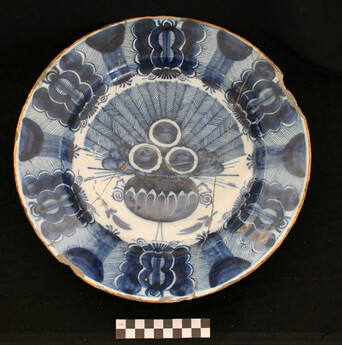The De Drie Klokken "Peacock" Delftware Plate
Learn more about Plimoth Patuxet Museums' collection and the De Drie Klokken "Peacock" Delftware Plate (31.59). The plate was made in Holland in the mid-18th century.

This large, decorated plate was made in Holland in the mid-18th century and is a type of ceramic commonly known as Delftware or Delft Blue. Delftware is an earthenware covered with a white tin-glaze manufactured between the 17th and 19th centuries in Holland. When production of tin-glazed pottery began in Holland in the 1600s, the Delft region dominated production, causing all of this type of Dutch pottery to be called Delftware, regardless of its place of origin. Several other European countries also produced tin-glazed ceramics, which they called by other names, such as majolica and faience. Unless they know the exact place of origin of a ceramic sherd, archaeologists often refer to this whole category of pottery as “tin-glazed ceramic.”

In the early years of tin-glazed ceramic production in Holland, many potters imitated the “majolica” style, which originated in Italy and Spain, in their designs. Soon after, however, the Dutch East India Trading company began importing blue and white Chinese porcelain, which became extremely fashionable in European Courts. European potters were unable to copy the delicate forms of porcelain because they did not have access to the correct type of clay, so instead they began imitating the Chinese designs on their tin-glazed ceramics in an effort to keep up with demand. In its heyday, there were about 30 delft factories in the Netherlands, but today only 1 factory remains: Royal Delft. Around 1800, demand for Delftware declined due the growing popularity of mass- produced English creamware, which was cheaper, stronger and superior in terms of usability.
The object shown here is a fine example of this Dutch blue and white tin-glazed earthenware. It has been hand-painted with a design that features a border of geometric and vegetable patterns and a central image of an urn holding peacock feathers. It is often referred to as the “peacock design.” The very edge of it has been painted with a yellow border. The base has a maker’s mark featuring three bells from De Drie Klokken (The Three Clocks) factory and was used to date the plate to circa 1750.
De Drie Klokken factory was founded by Barbara Cornelisdochter Rotteveel in 1670 in a building that had previously held a brewery. Her grandson, Peter Mesch, inherited the factory in 1706. His widow, Maria van Ophoven, and her second husband, Hendrik van Willigen, ran the factory afterwards. In 1743 Adriaan van der Does bought the company and he and his family would have been the owners at the time this plate was created.
To learn more about Plimoth Patuxet’s collection click here.